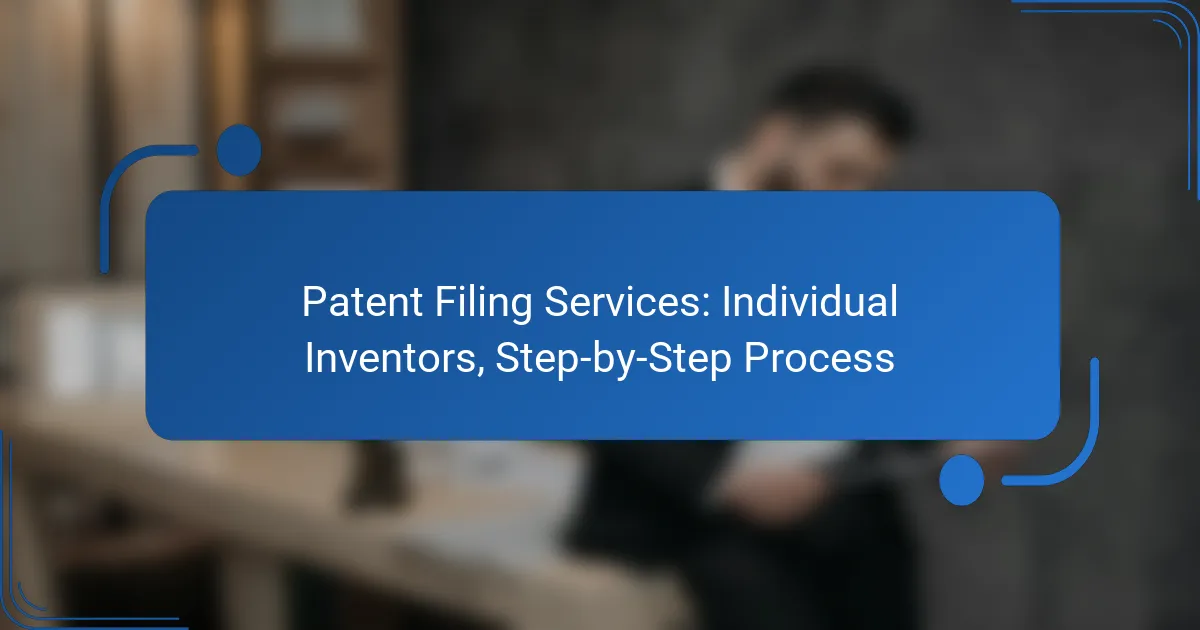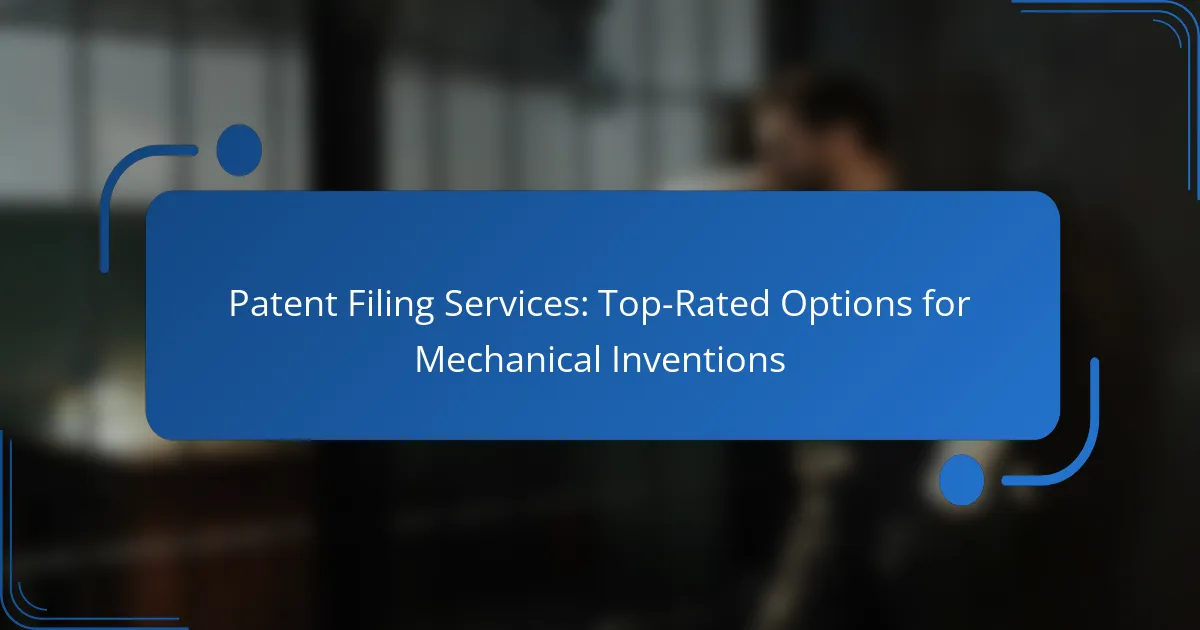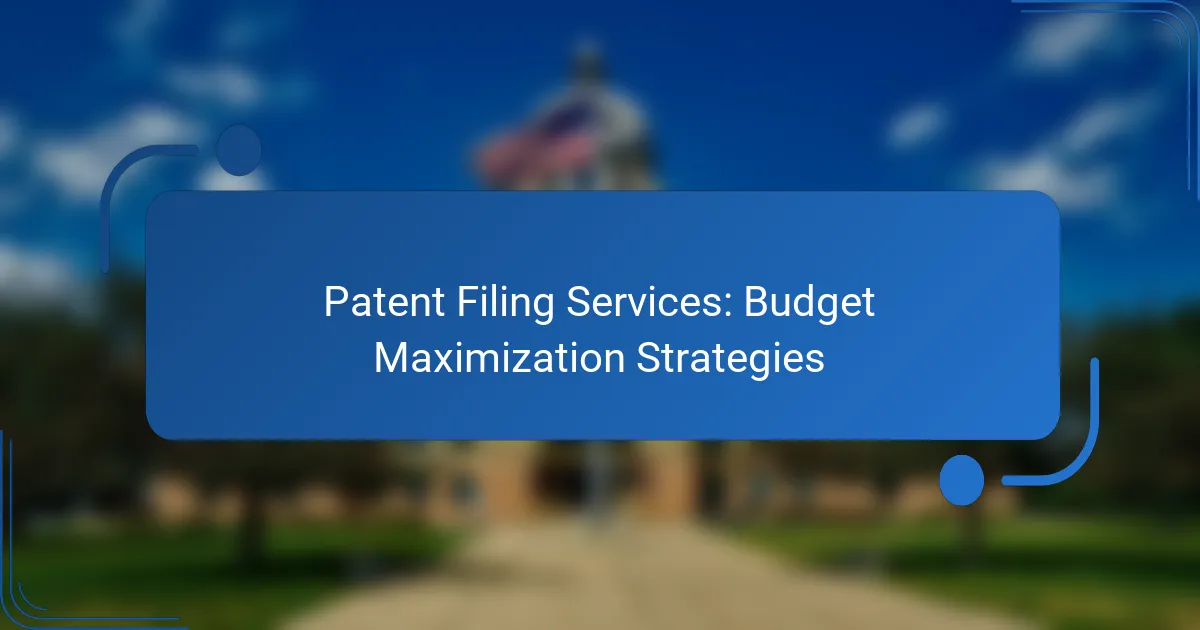In the rapidly evolving landscape of software innovations, securing intellectual property through effective patent filing services is essential for inventors. These services encompass a range of offerings, including provisional and non-provisional applications, patentability assessments, and expert support throughout the patent prosecution process. Selecting the right service provider is crucial, particularly one with specialized knowledge in software patents, to navigate the complexities of the patent system effectively.
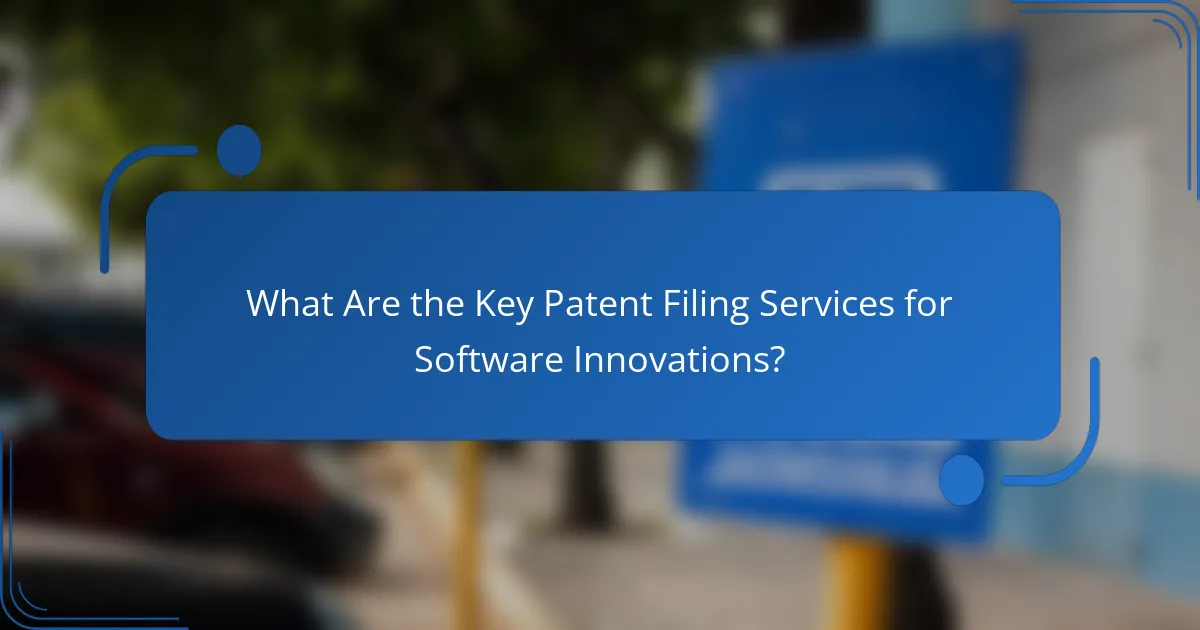
What Are the Key Patent Filing Services for Software Innovations?
Key patent filing services for software innovations include provisional and non-provisional patent applications, patentability assessments, patent drafting services, and patent prosecution support. These services help inventors protect their intellectual property and navigate the complexities of the patent system.
Provisional patent applications
A provisional patent application provides a cost-effective way to secure an early filing date for your software innovation without the formal requirements of a non-provisional application. It allows you to label your invention as “patent pending” for up to one year while you refine your product or seek funding.
Consider filing a provisional application if you need time to develop your software further or if you want to test the market before committing to a full patent. Keep in mind that a provisional application cannot be renewed, so you must file a non-provisional application within the year to maintain your priority date.
Non-provisional patent applications
A non-provisional patent application is the formal request for a patent that includes detailed claims, drawings, and an abstract of your software invention. This application undergoes examination by the patent office, which assesses its novelty and compliance with patent laws.
When preparing a non-provisional application, ensure that your claims are clear and well-defined. This application must be filed within one year of the provisional application if you want to benefit from the earlier filing date. The costs associated with non-provisional applications can vary widely, often ranging from several thousand to tens of thousands of dollars depending on complexity.
Patentability assessments
Patentability assessments evaluate whether your software innovation is eligible for patent protection based on criteria such as novelty, non-obviousness, and utility. This service typically involves a prior art search to identify existing patents and publications that may affect your invention’s patentability.
Conducting a patentability assessment before filing can save time and resources by identifying potential obstacles early. It is advisable to work with a patent attorney who can provide insights into the likelihood of success and help refine your claims accordingly.
Patent drafting services
Patent drafting services focus on creating a comprehensive patent application that clearly describes your software innovation and its unique features. A well-drafted application is crucial for protecting your invention and can significantly impact the success of your patent prosecution.
Engaging a professional patent drafter is recommended, as they understand the nuances of patent law and can craft claims that maximize protection. Ensure that the drafter has experience with software patents, as this field has specific requirements and challenges.
Patent prosecution support
Patent prosecution support involves assistance throughout the examination process of your patent application, including responding to office actions and negotiating with patent examiners. This support is essential for overcoming objections and ensuring that your application meets all legal requirements.
Consider hiring a patent attorney for prosecution support to navigate complex legal language and technical arguments effectively. This can enhance your chances of obtaining a patent while minimizing delays and potential rejections from the patent office.
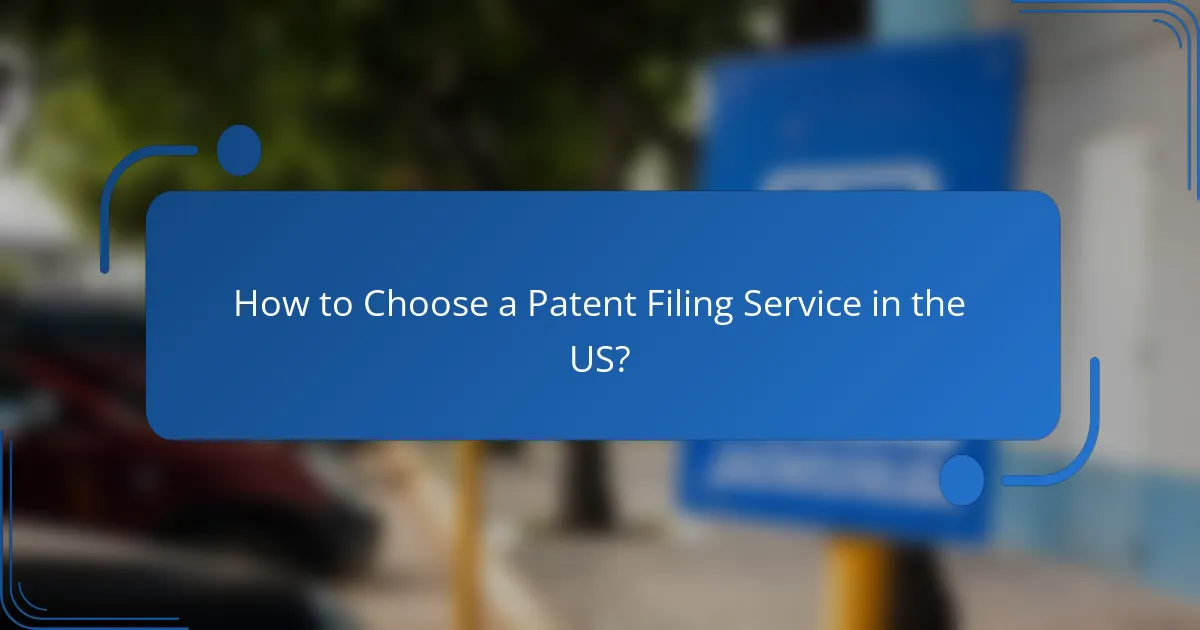
How to Choose a Patent Filing Service in the US?
Choosing a patent filing service in the US involves assessing their expertise, client feedback, pricing, and efficiency. Focus on firms that specialize in software patents, as they understand the unique challenges and requirements of this field.
Experience with software patents
When selecting a patent filing service, prioritize those with a proven track record in handling software patents. These firms should demonstrate familiarity with the complexities of software innovations, including algorithms and user interfaces.
Look for services that have successfully filed patents for similar technologies. This experience can significantly enhance the chances of your patent being granted, as they will know how to navigate potential pitfalls and objections from the patent office.
Client testimonials and success rates
Client testimonials provide insight into the reliability and effectiveness of a patent filing service. Seek out reviews that specifically mention successful software patent filings, as these will give you a clearer picture of the firm’s capabilities.
Consider asking for case studies or statistics on their success rates. A reputable service will be transparent about their performance, showcasing how many patents they have successfully filed and the outcomes for their clients.
Cost structure and transparency
Understanding the cost structure of a patent filing service is crucial. Look for firms that offer clear pricing models, detailing all potential fees, including filing, attorney, and maintenance costs.
Avoid services that are vague about their pricing; transparency is key. Some firms may offer flat fees, while others charge hourly rates. Ensure you understand what services are included to avoid unexpected expenses.
Turnaround time for filings
Turnaround time can vary significantly between patent filing services. Inquire about their average processing times for software patents, as delays can impact your innovation’s market entry.
Choose a service that provides a realistic timeline and adheres to it. Fast turnaround is beneficial, but ensure that speed does not compromise the quality of the patent application. Aim for a balance between efficiency and thoroughness in the filing process.

What Are the Costs Associated with Patent Filing Services?
The costs associated with patent filing services can vary significantly based on several factors, including the complexity of the invention, the type of service provider, and additional requirements. Understanding these costs is crucial for budgeting and ensuring your innovation is adequately protected.
Flat fees vs. hourly rates
Patent filing services may charge either a flat fee or an hourly rate. Flat fees provide predictability, often covering the entire process from initial consultation to filing, while hourly rates can lead to higher costs if the process takes longer than expected. It’s essential to evaluate which pricing model aligns better with your needs and budget.
For example, a flat fee for a basic utility patent application might range from $5,000 to $15,000, while hourly rates can vary, typically falling between $200 and $500 per hour. Consider the complexity of your invention when choosing between these options.
Additional costs for revisions
Revisions to your patent application can incur additional costs, especially if significant changes are needed after initial submission. Service providers may charge extra for each round of revisions, which can add up quickly if multiple changes are required. It’s advisable to clarify revision policies and potential costs upfront.
For instance, some firms may include a limited number of revisions in their flat fee, while others might charge separately, potentially costing hundreds to thousands of dollars depending on the extent of changes needed.
Government filing fees
In addition to service provider fees, government filing fees are a critical component of the overall cost. These fees vary by country and type of patent, with the United States Patent and Trademark Office (USPTO) charging different amounts for utility, design, and plant patents. For example, utility patent filing fees can range from a few hundred to several thousand dollars.
It’s important to account for these fees in your budget, as they are non-refundable and must be paid at the time of filing. Research the specific fees applicable in your jurisdiction to avoid surprises.
Potential maintenance fees
Once a patent is granted, maintenance fees may be required to keep the patent active. These fees are typically due at regular intervals, such as every few years, and can increase over time. For example, in the U.S., maintenance fees for a utility patent can range from a few hundred to several thousand dollars depending on the age of the patent.
Be proactive in planning for these costs, as failing to pay maintenance fees can result in the loss of patent rights. Keeping track of due dates and amounts is essential for maintaining your patent’s protection.

What Are the Common Challenges in Patent Filing for Software?
Patent filing for software often presents unique challenges, primarily due to the complexity of software patentability, the need for thorough prior art searches, effective claim drafting, and responding to office actions. Navigating these hurdles requires a clear understanding of the patent process and careful attention to detail.
Complexity of software patentability
The patentability of software can be intricate, as it must meet specific criteria such as novelty, non-obviousness, and usefulness. Unlike physical inventions, software often blurs the lines between abstract ideas and practical applications, making it essential to demonstrate how the software provides a tangible benefit.
To enhance patentability, focus on detailing the technical aspects of your software, including algorithms and processes. Consider consulting with a patent attorney who specializes in software to ensure compliance with legal standards and to strengthen your application.
Prior art searches
Conducting a thorough prior art search is crucial to identify existing patents, publications, and products that may affect your software’s patentability. This process helps you understand the competitive landscape and refine your invention to ensure it is unique.
Utilize online databases such as Google Patents or the United States Patent and Trademark Office (USPTO) to conduct preliminary searches. Engaging a professional search firm can also provide a more comprehensive analysis, increasing your chances of a successful patent application.
Drafting claims effectively
Effective claim drafting is vital for defining the scope of your patent protection. Claims should be clear, concise, and specific, outlining the unique features of your software while avoiding overly broad language that could lead to rejection.
Consider using a mix of independent and dependent claims to cover various aspects of your invention. This strategy allows for flexibility in enforcement and can help address potential challenges during the examination process.
Responding to office actions
Responding to office actions from patent examiners is a critical step in the patent filing process. These communications may request clarifications, amendments, or additional information regarding your application.
Timely and well-prepared responses can significantly influence the outcome of your application. It is advisable to work closely with a patent attorney to address any concerns raised by the examiner and to strengthen your position for approval.
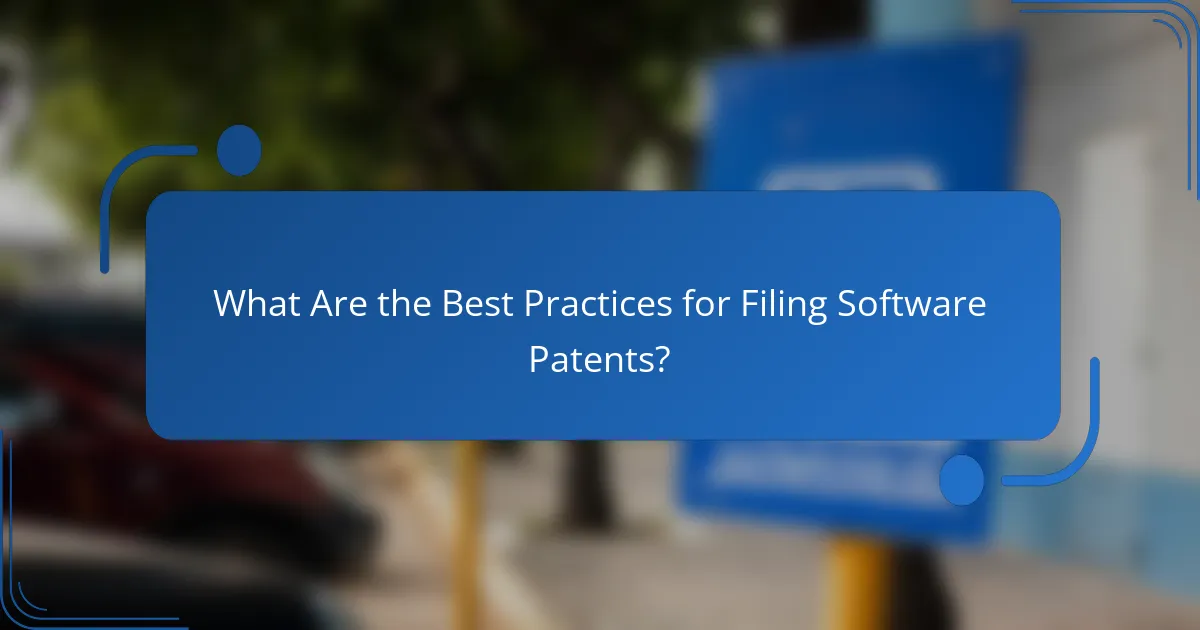
What Are the Best Practices for Filing Software Patents?
Best practices for filing software patents include thorough documentation of the innovation, understanding patent eligibility, and ensuring claims are clear and specific. These steps help streamline the application process and increase the likelihood of approval.
Understand Patent Eligibility
Software patents must meet specific criteria to be considered eligible. Generally, the invention must be novel, non-obvious, and useful. Additionally, it should provide a technical solution to a technical problem, which is crucial in jurisdictions like the United States and Europe.
To assess eligibility, consider whether your software offers a unique process or functionality that is not merely an abstract idea. For example, a new algorithm that improves data processing speed may qualify, while a basic app idea without unique features may not.
Document Your Innovation Thoroughly
Comprehensive documentation is vital for a successful patent application. This includes detailed descriptions of the software’s functionality, flowcharts, diagrams, and any prototypes. Clear documentation helps patent examiners understand the innovation and its significance.
Maintain records of development stages, including notes on brainstorming sessions and revisions. This can be useful in demonstrating the evolution of your idea and its uniqueness.
Craft Clear and Specific Claims
The claims section defines the scope of your patent and should be written clearly and specifically. Each claim should outline a distinct aspect of the invention, avoiding vague language. This clarity helps prevent infringement issues and strengthens your patent’s enforceability.
Consider using multiple dependent claims to cover various aspects of your software. For instance, if your software includes a unique user interface and a novel algorithm, each should have its own claim to ensure comprehensive protection.
Consult with a Patent Attorney
Engaging a patent attorney can significantly enhance your filing process. They can provide insights into the nuances of patent law and help draft claims that maximize protection. An attorney can also guide you through the complexities of the application process, ensuring compliance with relevant regulations.
While hiring an attorney involves costs, their expertise can save time and increase the chances of a successful patent grant, making it a worthwhile investment.

